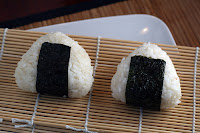 |
| Image Source |
Onigiri is sold everywhere in Japan from conbini (convenience stores), and supermarkets to food halls. Onigiri has even become popular overseas in the last few years thanks to anime and manga.
What kind of rice to use for Onigiri
The japonica variety of rice grown in Japan is softer and stickier than other kinds of rice when cooked. Pressed by hand it retains its shape well making it ideal for onigiri. The onigiri rice is usually flavoured with just salt, but is moulded using your bare hands dipped in water. They are best eaten at room temperature.Onigiri Fillings
Popular fillings include:• umeboshi (pickled plum)
• shiozake (salted salmon)
• tarako (salty cod roe)
• okaka (bonito flakes with soy sauce)
• tuna with mayonnaise
• shrimp tempura (tenmusu)
Onigiri is usually wrapped in dried nori seaweed, which makes the onigiri easy to hold and keeps the rice soft and moist.
Onigiri Shapes
There are many different shapes of onigiri. Traditional shapes include triangle, oval and tawara (cylinder).Different Types of Onigiri
• Traditional type, which is a filled onigiri wrapped in nori• Sprinkled type, which is an onigiri covered in some kind of seasoning such as furikake (mixed seasoning) or gomashio (sesame seeds with salt)
• Mixed rice type, which is an onigiri where the rice has been mixed with something else such as a seasoning and then shaped
Another popular way to eat onigiri is yaki-onigiri. Coat the rice with miso or soy sauce then lightly grill the rice. These are best eaten hot.
Japanese Onigiri Recipe
What's your favourite Onigiri? Please leave a comment below.











.png)







